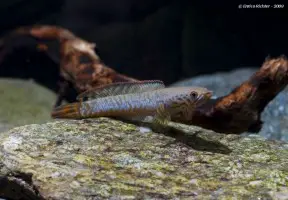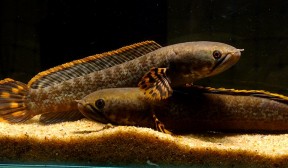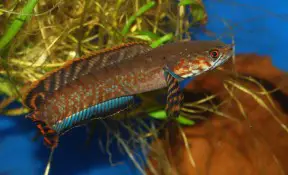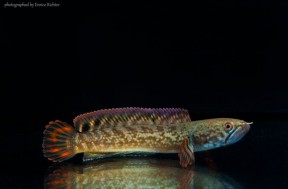Channa bleheri
Rainbow snakehead
Etymology
Channa: from the Latin channe, used to refer to an unspecified species of sea perch.
bleheri: named for German fish collector Heiko Bleher, who collected the type series.
Classification
Order: Perciformes Family: Channidae
Distribution
Endemic to the Brahmaputra River basin in the states of Assam and Arunachal Pradesh, northeastern India, with the full extent of its distribution unclear.
It is apparently restricted to the northern portion of Assam, while in Arunachal Pradesh it has been collected in the vicinity of Doimukh in the Dikrong river drainage.
Type locality is ‘Upper Diburu near Guijam, Assam, India’.
Habitat
The area in which C. bleheri lives has a ‘tropical monsoon rainforest’ climate characterised by heavy rainfall, high humidity and hot summer temperatures.
Goswami et al. (2006) report that the fish construct burrows close to tree stumps in forested areas which are temporarily inundated during the annual monsoons. These are used as refuges during the dry winter months, with the fish emerging to hunt and breed while the habitat is flooded.
Since it is less of an ecological generalist than many Channa species, requires a specific type of microhabitat, has a restricted range, and is never found in large numbers it is recommended as a concern for conservation by Goswami et al., 2006., who also note that it is ‘rampantly fished’ for food and the ornamental trade.
Like others in the genus it can tolerate hypoxic conditions due to its ability to breath atmospheric air (see ‘Notes’).
Maximum Standard Length
140 – 170 mm.
Aquarium SizeTop ↑
An aquarium with base dimensions of 120 ∗ 30 cm or equivalent is recommended.
Depth is less important but should not be less than 30 cm.
Maintenance
Prefers a dimly-lit aquarium with a layer of surface vegetation such as Ceratopteris spp. plus some submerged cover.
It is essential to use a tightly-fitting hood since Channa spp. are notorious for their ability to escape, and a gap should be left between this and the water surface as they require access to a layer of humid air.
More importantly still C. bleheri must not be maintained at a constant temperature but provided with natural seasonal variation in the form of defined winter and summer periods. During the colder period the fish do not require much food and the water level can be allowed to fall without additional top-ups.
Water Conditions
Temperature: 14 – 28 °C
pH: 6.0 – 8.0
Hardness: 36 – 357 ppm
Diet
An obligate predator which probably feeds on smaller fishes and insects in nature, but in most cases adapts well to dead alternatives in captivity. Some specimens may accept dried foods though these should never form the staple diet.
Young fish can be offered chironomid larvae (bloodworm), small earthworms, chopped prawn and suchlike, while adults will accept strips of fish flesh, whole prawns, mussels, live river shrimp, larger earthworms, etc.
This species should not be fed mammalian or avian meat such as beef heart or chicken since some of the lipids contained in these cannot be properly metabolised by the fish and may cause excess fat deposits and even organ degeneration. Similarly there is no benefit in the use of ‘feeder’ fish such as livebearers or small goldfish which carry with them the risk of parasite or disease introduction, and tend not have a high nutritional value unless properly conditioned beforehand.
Behaviour and CompatibilityTop ↑
In general Channa are best-maintained in species-specific aquaria, although C. bleheri can be kept in a well-chosen community arrangement alongside peaceful, non-territorial tankmates that are too large to be viewed as prey.
Young specimens can be maintained together but usually begin to display aggressive behaviour towards one another as they become sexually mature, although this does vary somewhat between individuals. If a pair forms they are usually peaceful towards one another but hostile to other conspecifics.
Sexual Dimorphism
Females tend to grow larger and are deeper-bodied than males, especially when gravid.
Reproduction
A biparental free spawner which has been bred regularly in aquaria.
At the peak of courtship the male and female embrace in a similar fashion to anabantoids.
No bubble nest is built and several thousand eggs simply float at the surface with both male and female remaining to defend the eggs and fry.
NotesTop ↑
C. bleheri is a popular aquarium fish, though it remains unclear whether collection for the ornamental trade is having a detrimental effect on wild populations (see ‘Habitat’).
It is one of several genus members to lack pelvic fins and can be further distinguished from other Channa species by the following combination of characters: sides of lower jaw with one large cycloid scale; lateral line complete with 46-50 scales; 14 pectoral-fin rays; 25 anal-fin rays; 4-11 irregular reddish orange markings on the caudal-fin which may be separate or conjoined; 6-8 alternating dark and light markings on pectoral-fin; maxilla and premaxillary processes extending beyond posterior margin of orbit; branchial toothplates 5 and present only on outer side of first gill arch.
Wild populations vary somewhat in colour pattern with some more bluish and others brownish or reddish (see images), and some specimens also possess rounded dark blotches in the posterior portion of the dorsal-fin.
Members of the family Channidae are commonly referred to as ‘snakeheads’ due to possession of large scales on the head of most species which are reminiscent of the epidermal scales (cephalic plates) on the heads of snakes. There currently exist over 30 valid species but diversity within the group is likely to prove significantly greater.
The existence of distinct phylogenetic groups has been proposed with the putative C. gachua species assemblage of Britz (2008) containing C. orientalis, C. gachua, C. bleheri, C. burmanica, C. barca, C. aurantimaculata, and C. stewartii.
Species from northeastern India have also been divided into the C. marulius and C. gachua groups (Vishwanath and Geetakumari, 2009).
C. bleheri was included in the latter assemblage which is is characterised by the following combination of characters: presence of a U-shaped isthmus; cephalic sensory pores evenly arranged in a single row; presence of one or two large cycloid scales on each side of the lower jaw; absence of a sharp prominent spine-like hypurapophysis; absence or presence of one tooth plate in the epibranchial; absence of an elongated urostyle.
All Channa spp. possess supplementary breathing apparatus in the form of paired suprabranchial chambers located behind and above the gills, although these are not labyrinthic but lined with respiratory epithelium. These chambers allow the fish to breathe atmospheric air and survive in hypoxic conditions or even out of the water for a considerable period of time, and in aquaria they are often seen rising to the surface to take gulps of air.
References
- Vierke, J., 1991 - Das Aquarium 25(259): 20-24
Ein farbenfroher neuer Schlangenkopffisch aus Assam: Channa bleheri spec. nov. - Brede, N. and P. Antler, 2009 - Natur und Tier Verlag, Münster: 62 pp.
Schlangenkopffische—Die Gattungen Channa und Parachanna. - Britz, R., 2008 - Ichthyological Exploration of Freshwaters 8(4) [for 2007]: 335-344
Channa ornatipinnis and C. pulchra, two new species of dwarf snakeheads from Myanmar (Teleostei: Channidae). - Goswami, M. M., B. Arunav and P. Janardan, 2006 - Journal of the Inland Fisheries Society of India 38(1): 1-8
Comparative biometry, habitat structure and distribution of endemic snakehead (Teleostei: Channidae) species of Assam, India. - Musikasinthorn, P., 2000 - Ichthyological Research 47(1): 27-37
Channa aurantimaculata, a new channid fish from Assam (Brahmaputra River basin), India, with designation of a neotype for C. amphibeus (McClelland, 1845). - Vishwanath, W. and Kh. Geetakumari, 2009 - Journal of Threatened Taxa 1(2): 97- 105
Diagnosis and interrelationships of fishes of the genus Channa Scopoli (Teleostei: Channidae) of northeastern India.















